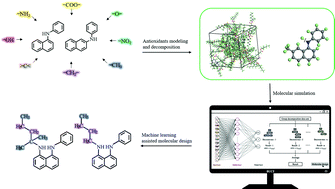Machine-learning-assisted molecular design of phenylnaphthylamine-type antioxidants†
Abstract
In this study, a total of 302 molecular structures of phenylnaphthylamine antioxidants based on N-phenyl-1-naphthylamine and N-phenyl-2-naphthylamine skeletons with various substituents were modeled by exhaustive methods. Antioxidant parameters, including the hydrogen dissociation energy, solubility parameter, and binding energy, were calculated through molecular simulations. Then, a group decomposition scheme was determined to decompose 302 antioxidants. The antioxidant parameters and decomposition results constituted machine-learning data sets. Using an artificial neural network model, a correlation coefficient between the predicted and true values above 0.88 and an average relative error within 6% were achieved. Random forest models were used to analyze the factors affecting antioxidant activity from chemical and physical perspectives; the results showed that amino and alkyl groups were conducive to improving antioxidant performance. Moreover, substituent positions 1, 7, and 10 of N-phenyl-1-naphthylamine and 3, 7, and 10 of N-phenyl-2-naphthylamine were found to be the optimal positions for modifications to improve antioxidant activity. Two potentially efficient phenylnaphthylamine antioxidant structures were proposed and their antioxidant parameters were also calculated; the hydrogen dissociation energy and solubility parameter decreased by more than 9% and 7%, respectively, whereas the binding energy increased by more than 16% compared with the benchmark of N-phenyl-1-naphthylamine. These results indicate that molecular simulation and machine learning could provide alternative tools for the molecular design of new antioxidants.



 Please wait while we load your content...
Please wait while we load your content...